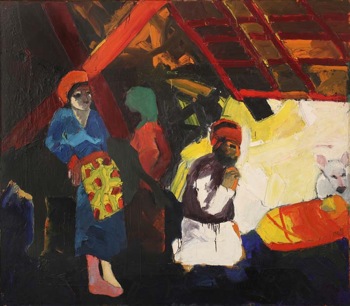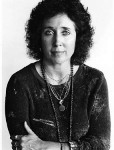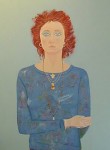


Joan Brown
American, 1938-1990
Gypsy Nativity, 1960
oil on canvas
67 3/8 x 77 1/4 in.
SBMA, Museum Purchase with funds provided by the Challenge Fund, 20th Century Art Quasi Endowment Fund and Judith Little
2012.29

Joan Brown, Self Portrait, 1960, oil on canvas, 21 x 19", © courtesy of the Artist and Paul Thiebaud Gallery, SF.
“How do I know when I’ve finished a painting? It’s when that element of surprise is there. I can feel the flow start to happen just in terms of working, which is actually an altered state of consciousness,” Brown says in this interview with Kate Horsfield.
COMMENTS
About the Artist:
It has been over half a century since the exhibition, Contemporary Bay Area Figurative Painting, organized by former SBMA Director Paul Mills for the Oakland Art Museum in 1957, first identified the remarkable movement known as Bay Area Figurative Art. From then to the mid-1960s, it surpassed many other national movements in coherence, significant, and notoriety.
Joan Brown was the sole female member to have been included in the upper echelons of the movement’s history, and one of its youngest. Pioneers David Park and Richard Diebenkorn set the stage with figurative imagery that defiantly challenged a culture saturated with the global impact of Abstract Expressionism. Theophilus Brown, Nathan Oliveira, and Paul Wonner fell in step, fortifying the bourgeoning movement as a unique and provocative force in contemporary art. All of these artists—except for Brown—are represented in SBMA’s permanent collection with major paintings.
Brown studied with Elmer Bischoff and Frank Lobdell at the College of Arts and Crafts (now the CCA), alongside Manuel Neri—another major player in the movement who Brown later married (who we have yet to add to the permanent collection!). Upon her untimely death in 1990, she had the distinction of being one of the most accomplished female artists on not only the West Coast, but also in the nation.
About this work:
Gypsy Nativity is discussed extensively in the artist’s monograph, The Art of Joan Brown, the book that accompanied the artist’s retrospective exhibition in 1998. A contemporary take on the classic nativity scene, the painting is extraordinary as a prime example of not only Bay Area Figurative Art but also the artist’s mature oeuvre. It falls within the years acknowledged by critics as her mature or peak years: 1960-65 (many critics suggest 1955-1965, with the caveat that she was in school for the first 5 years of that period); and it embodies every critical aspect of what has been determined the artist’s best work. Along with four other paintings completed in 1960-61, according to her monograph, this body of work “clearly defines the main subjects that recurred consistently throughout Brown’s lifetime of work—her intense self-scrutiny and recording of her private life and her reflections on her creative activities in the studio as an artist.” Gypsy Nativity distinctively exemplifies the artist’s preoccupation with the depiction with light, and her obsession with the “drama of light and dark” of Rembrandt—an artist with whom she was preoccupied during her peak. As the only painting currently available dating from her mature years, it is a rare find.
Exhibited:
1960 Joan Brown: Paintings/Robert Beverly Hale: Recent Drawings, Staempfli Gallery, New York. 29 March – 16 April.
1961 Recent Paintings by Joan Brown, Batman Gallery, San Francisco. 12 January – 8 February.
1992 Putting on the Dog, Lobby of Transamerica Building, San Francisco. 4 February – 26 March.
1998 Transformation: The Art of Joan Brown, University of California, Berkeley Art Museum and the Oakland Museum of California. 26 September 1998 – 17 January 1999.
2011 Joan Brown, Gallery Paule Anglim, San Francisco. 6-30 April.
Selected References:
Karen Tsujimoto and Jacquelyyn Baas, The Art of Joan Brown, Santa Barbara Museum of Art. 1998: University of California Press, Berkeley and Los Angeles.
Gypsty Nativity Catalogue Number 12 (page 43).
[Exhibition catalogue for Transformation: The Art of Joan Brown organized by the University of California, Berkeley Art Museum and the Oakland Museum of California, and seen simultaneously at both institutions 26 September 1998 – 17 January 1999.]
Bay Area Figurative Art, 1950-1965. 1990: University of California Press, Berkeley and Los Angeles. [Exhibition catalogue for exhibition of the same title organized by the San Francisco Museum of Modern Art, 14 December 1989 – 4 February 1990; traveled to the Hirshhorn Museum and Sculpture Garden, Smithsonian Institution, and to the Pennsylvania Academy of the Fine Arts.]
- SBMA curatorial email to Docent Council, Summer, 2012
SBMA CURATORIAL LABELS
Joan Brown is recognized for her role in Bay Area Figurative Art, a movement established in the early 1950s in reaction to East and West Coast varieties of Abstract Expressionism. She was the sole female member to have been included in the upper ranks of the movement, and one of its youngest. Brown studied with Elmer Bischoff at the California School of Fine Arts. Her primary influences were the abstract work of Frank Lobdell and the figurative painting of Bischoff and David Park. She ultimately developed her own unique style of thickly painted figuration which brought her acclaim early in her career. Upon her untimely death in 1990, she had the distinction of being one of the most accomplished female artists on the West Coast and in the nation.
Gypsy Nativity is an exceptional painting from the heart of the decade many critics claim are the artist’s best.
- Ridley-Tree Gallery 2016
